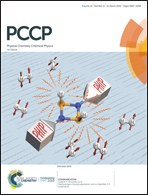O2 formation in cold environments†
Abstract
The diffusional dynamics of atomic oxygen in and on amorphous solid water (ASW) to form molecular oxygen is characterized. Reactive molecular dynamics simulations to study bond breaking and bond formation show that vibrational relaxation of the highly excited diatomic occurs on the 10 ns to 100 ns time scale. The relaxation process is highly nonexponential and can be characterized by a stretched exponential decay reminiscent of the dynamics of glasses. The stretched exponents range from β = 0.15 for relaxation on the surface to β = 0.21 for the dynamics in bulk. It is also found that coupling of the O2 relaxation to the internal water modes occurs which speeds up the vibrational relaxation by a factor of 4. Extrapolation of the stretched exponential decay to 1 μs yields a final vibrational quantum number v = 2 for O2(X3Σ−g), consistent with experimental results from photolysis of SO2 on ASW at 193 nm which find v ≤ 3. Desorption energies of water from the surface range from 1.5 to 2.0 kcal mol−1 compared with 1.8 kcal mol−1 found from experiment, depending on whether the water molecules are flexible or not.



 Please wait while we load your content...
Please wait while we load your content...